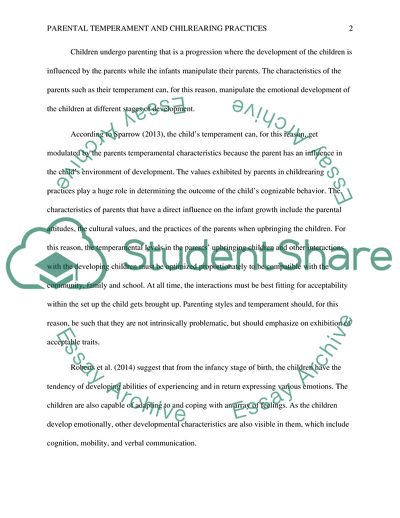Cite this document
(Child Neurobiological Underpinnings of Best-Fit Parental Temperament Essay Example | Topics and Well Written Essays - 1750 words, n.d.)
Child Neurobiological Underpinnings of Best-Fit Parental Temperament Essay Example | Topics and Well Written Essays - 1750 words. https://studentshare.org/sociology/1857450-child-neurobiological-underpinnings-of-best-fit-parental-temperament-and-childrearing-practices-at-specific-brain-development-stages-eg-neonatal-infancy-toddlerhood
Child Neurobiological Underpinnings of Best-Fit Parental Temperament Essay Example | Topics and Well Written Essays - 1750 words. https://studentshare.org/sociology/1857450-child-neurobiological-underpinnings-of-best-fit-parental-temperament-and-childrearing-practices-at-specific-brain-development-stages-eg-neonatal-infancy-toddlerhood
(Child Neurobiological Underpinnings of Best-Fit Parental Temperament Essay Example | Topics and Well Written Essays - 1750 Words)
Child Neurobiological Underpinnings of Best-Fit Parental Temperament Essay Example | Topics and Well Written Essays - 1750 Words. https://studentshare.org/sociology/1857450-child-neurobiological-underpinnings-of-best-fit-parental-temperament-and-childrearing-practices-at-specific-brain-development-stages-eg-neonatal-infancy-toddlerhood.
Child Neurobiological Underpinnings of Best-Fit Parental Temperament Essay Example | Topics and Well Written Essays - 1750 Words. https://studentshare.org/sociology/1857450-child-neurobiological-underpinnings-of-best-fit-parental-temperament-and-childrearing-practices-at-specific-brain-development-stages-eg-neonatal-infancy-toddlerhood.
“Child Neurobiological Underpinnings of Best-Fit Parental Temperament Essay Example | Topics and Well Written Essays - 1750 Words”. https://studentshare.org/sociology/1857450-child-neurobiological-underpinnings-of-best-fit-parental-temperament-and-childrearing-practices-at-specific-brain-development-stages-eg-neonatal-infancy-toddlerhood.


